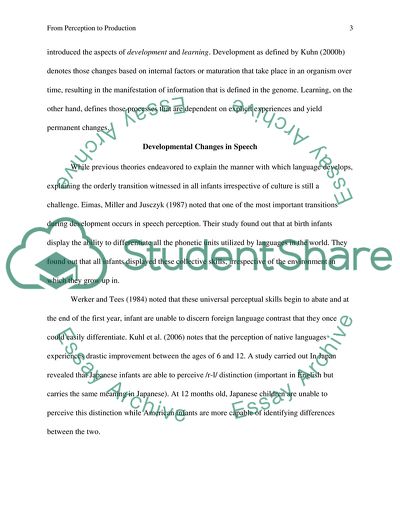Cite this document
(From Perception to Production: Kuhns NLM and NLM-e Coursework Example | Topics and Well Written Essays - 3000 words, n.d.)
From Perception to Production: Kuhns NLM and NLM-e Coursework Example | Topics and Well Written Essays - 3000 words. https://studentshare.org/humanitarian/1818289-to-what-extent-can-kuhls-2001-native-language-magnet-or-kuhl-et-als-2008-nlm-e-theories-explain-the-transition-from-perception-to-production
From Perception to Production: Kuhns NLM and NLM-e Coursework Example | Topics and Well Written Essays - 3000 words. https://studentshare.org/humanitarian/1818289-to-what-extent-can-kuhls-2001-native-language-magnet-or-kuhl-et-als-2008-nlm-e-theories-explain-the-transition-from-perception-to-production
(From Perception to Production: Kuhns NLM and NLM-E Coursework Example | Topics and Well Written Essays - 3000 Words)
From Perception to Production: Kuhns NLM and NLM-E Coursework Example | Topics and Well Written Essays - 3000 Words. https://studentshare.org/humanitarian/1818289-to-what-extent-can-kuhls-2001-native-language-magnet-or-kuhl-et-als-2008-nlm-e-theories-explain-the-transition-from-perception-to-production.
From Perception to Production: Kuhns NLM and NLM-E Coursework Example | Topics and Well Written Essays - 3000 Words. https://studentshare.org/humanitarian/1818289-to-what-extent-can-kuhls-2001-native-language-magnet-or-kuhl-et-als-2008-nlm-e-theories-explain-the-transition-from-perception-to-production.
“From Perception to Production: Kuhns NLM and NLM-E Coursework Example | Topics and Well Written Essays - 3000 Words”. https://studentshare.org/humanitarian/1818289-to-what-extent-can-kuhls-2001-native-language-magnet-or-kuhl-et-als-2008-nlm-e-theories-explain-the-transition-from-perception-to-production.


